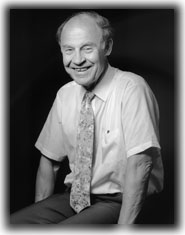Main Menu · Search ·Current Issue ·Contact ·Archives ·Centennial ·Letters to the Editor ·FAQs
[ Back to the main story ]
 Chemist Dudley Herschbach: "Beauty involves the
ability to understand things that didn't seem related--beneath this superficial
difference, we find this unity. When you see features of colliding atoms resembling those of rainbows in the
sky, it sort of grips you!"
Chemist Dudley Herschbach: "Beauty involves the
ability to understand things that didn't seem related--beneath this superficial
difference, we find this unity. When you see features of colliding atoms resembling those of rainbows in the
sky, it sort of grips you!" |
Ironically, the natural sciences are one area in which beauty has never lost its significance among scholars. Composer John Cage once mused that if art imitates nature, then advances in art should follow advances in our understanding of natural laws--in other words, the models provided by science. Baird professor of science Dudley Herschbach, who won the 1986 Nobel Prize in chemistry, also connects the two: "In science as in art, when you encounter a great piece of work, you can't see the same or think the same as you did before." Cabot professor of aesthetics and the general theory of value Elaine Scarry notes that at gatherings of Harvard's Society of Fellows, "The people in the arts never use the word 'beauty' or aesthetic words, but the scientists always do. They're likely to say, 'There's a very pretty answer to that,' or mention work by someone that was beautiful or elegant." Even computer programmers have a word--kludge--for cumbersome, inelegant program concepts. It is their version of "ugly."
"A lot of molecules are regarded as beautiful," Herschbach continues, "usually because they have some wonderful story about them"--the synthesis of palytoxin C129H223N3O54, accomplished in 1993 by Herschbach's colleague, Loeb research professor of chemistry Yoshito Kishi and coworkers, for example. The molecule is a highly poisonous neurotoxin that occurs naturally in marine soft corals. Its 409 atoms are joined in a "myriad of variant structures, termed stereoisomers, that have the atoms linked in the same way, but differ in the spatial configuration of bonds," Herschbach explains. There are twofold choices of configuration at 72 sites in the molecule, and hence 272 (or 5 x 1021) possible stereoisomeric structures. Yet only one of these possibilities is the actual biologically active neurotoxin.
Even so, the Kishi team succeeded in synthesizing the unique structure with the correct spatial configuration at each of the 72 different sites. "It's a molecule with no symmetry, but in the eyes of chemists, it's an incredibly beautiful thing. No one would believe you could make a molecule with all those bonds oriented the right way," says Herschbach. "It's like Beethoven--each element is trivial, but when you put it all together, it's incredible.
"Science is not primarily technical, it's architectural--you're building something," he elaborates. "Now, an architect needs to know a lot of technical stuff--otherwise buildings fall down. But the architect puts together the technical data to serve a larger purpose." In his chemistry class, Herschbach asks students to write poems, and notes that creating poetry is much like creating science. "When you are doing frontier work in science you don't know what you are doing. You're playing, you're gambling," he says. "Science isn't about knowing if it's right or wrong. Your real concerns are: Is this interesting? Am I asking interesting questions? Not understanding is part of the beauty. Mystery is essential."
Turning to his own lab, he observes, "In our work on molecular collisions we find phenomena analogous to rainbows in the sky. In rainbows you get a focusing effect, and from the refraction of light you get colors. With atoms, we're able to see three or four rainbows. Beauty involves the ability to understand things that didn't seem related--beneath this superficial difference, we find this unity. When you see features of colliding atoms resembling those of rainbows in the sky, it sort of grips you!"
Mathematicians may discover the most abstract unities of all. Petschek professor of mathematics Barry Mazur observes that "mathematics is intensely beautiful, but still the connection between mathematics and beauty baffles me. Mathematicians pursue understanding, not beauty. And the extremes of understanding can only be found in the murkiest of waters, the darker the better. It is too dark down there to tell whether what you are grappling with is beautiful or not. The surprise, after you rise to the surface with the beast in hand, is that it is." He quotes Isak Dinesen:
Straight is the line of duty,
Curved is the line of beauty.
Follow the straight line; thou shalt see
The curved line ever follows thee.
"We could reinterpret these lines by thinking of one's 'duty' as 'pursuit of understanding,' and get the right degree of puzzlement regarding the appearance of beauty in mathematics," says Mazur. Beauty, then, might be a bonus awarded when one discovers some truth about the order of the universe. Mazur invites us to consider an example of mathematical beauty from Leonardo of Pisa (a.k.a. Fibonacci), who begins his treatise The Book of Squares, written in 1225, with this observation:
I thought about the origin of all square numbers and discovered that they arise out of the increasing sequence of odd numbers; for the unity is a square...; to this unity is added 3, making the second square, namely 4, with root 2; if to the sum is added the third odd number, namely 5, the third square is created, namely 9, with root 3; and the sums of consecutive odd numbers and the sequence of squares always arise together in order.